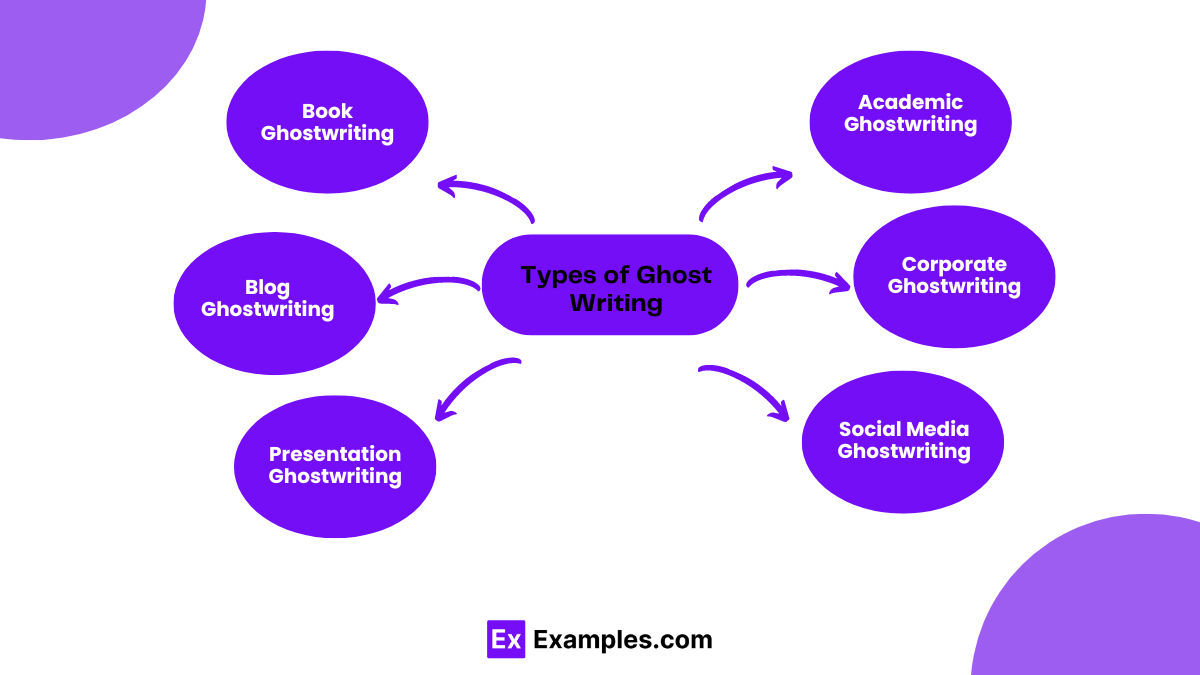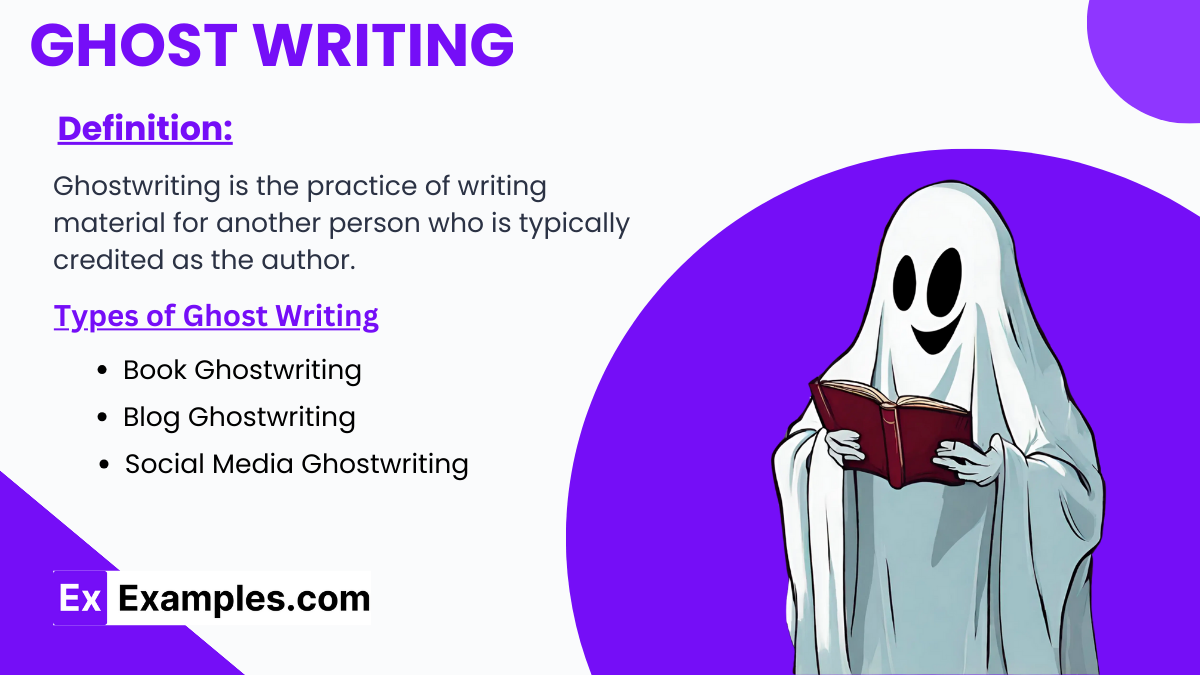Ghost Writing
Ghostwriting involves a skilled writer penning content on behalf of someone else who is typically credited as the author. This clandestine art requires a delicate balance of adopting the author’s voice, tone, and style while bringing creativity and expertise to the project. Whether it’s a novel, a memoir, an article, or a blog post, ghostwriters work behind the scenes, breathing life into ideas, stories, and messages without claiming ownership. They navigate the fine line between anonymity and collaboration, ensuring the final product resonates authentically with the intended audience while preserving the client’s vision.
What is Ghost Writing?
Ghostwriting is the practice of writing material for another person who is typically credited as the author. This can encompass a wide range of content, including books, articles, speeches, blog posts, and more. Ghostwriters are hired to capture the voice, tone, and style of the credited author while bringing their ideas and concepts to life. Often, ghostwriting involves extensive collaboration between the ghostwriter and the credited author, with the ghostwriter sometimes conducting interviews, research, and gathering information to ensure the final product aligns with the author’s vision. Confidentiality is a crucial aspect of ghostwriting, as the ghostwriter’s role is usually undisclosed or kept discreet. Ghostwriting enables individuals to share their stories, expertise, and messages without the burden of writing or the public recognition of authorship.
How do you Ghostwrite?
- Understand the Author’s Vision: Start by discussing the author’s goals, ideas, and vision for the piece. Understand their style, tone, and audience.
- Research and Gather Information: Conduct thorough research on the topic if necessary. Gather any existing materials, notes, or interviews provided by the author.
- Outline and Structure: Create an outline or structure for the piece based on the author’s vision and the gathered information. This serves as a roadmap for the writing process.
- Write the Draft: Using the outline as a guide, begin writing the draft while emulating the author’s voice and style. Stay true to their vision and incorporate any specific requests or feedback.
- Collaborate and Revise: Share the draft with the author for feedback. Collaborate closely to make revisions and adjustments until the author is satisfied with the content.
- Finalize and Deliver: Once revisions are complete, finalize the piece and deliver it to the author. Ensure that any confidentiality agreements or arrangements are respected.
- Maintain Confidentiality: Throughout the process, maintain confidentiality regarding your role as a ghostwriter, unless otherwise agreed upon with the author.
How to become a Ghostwriter
Becoming a ghostwriter typically involves honing your writing skills, building a portfolio, networking within the publishing industry, and establishing trust with potential clients. Here’s a step-by-step guide:
- Develop Your Writing Skills: Enhance your writing abilities by practicing regularly, studying different writing styles, and learning about various genres and formats.
- Build a Portfolio: Create a portfolio showcasing your writing abilities. Include samples that demonstrate your versatility and ability to adapt to different tones, voices, and subjects.
- Identify Your Niche: Determine your areas of expertise or interest. Specializing in specific topics or genres can help you stand out to potential clients looking for ghostwriters with relevant experience.
- Network: Connect with authors, editors, literary agents, and other professionals in the publishing industry. Attend writing conferences, join writing groups or forums, and use social media platforms to build relationships and expand your network.
- Market Yourself: Establish an online presence through a professional website or blog where you can showcase your portfolio and share insights about your writing process. Utilize social media and professional networking platforms to promote your services and engage with potential clients.
- Seek Opportunities: Look for job openings, freelance gigs, or opportunities to collaborate with authors, publishers, or literary agencies. Consider reaching out directly to authors who may need ghostwriting services for their projects.
- Develop Client Relationships: Cultivate trust and credibility with your clients by delivering high-quality work, meeting deadlines, and maintaining professionalism throughout the collaboration process.
- Protect Your Work: Establish clear contracts outlining the terms of your ghostwriting arrangements, including payment, credit, confidentiality, and ownership rights.
- Continuously Improve: Stay updated on industry trends, hone your craft, and seek feedback from clients and peers to enhance your skills and reputation as a ghostwriter.
Types of Ghost Writing

hostwriting encompasses various types tailored to the needs of clients across different industries:
1.Book Ghostwriting:
Ghostwriters craft entire books on behalf of clients, ranging from memoirs and autobiographies to fiction and non-fiction works.
2.Article and Blog Ghostwriting:
Ghostwriters produce articles, blog posts, and web content for individuals or organizations, maintaining the desired tone and style.
3.Speech and Presentation Ghostwriting:
Ghostwriters create speeches, presentations, and scripts for public figures, executives, and professionals, ensuring coherence, clarity, and impact.
4.Academic Ghostwriting:
Ghostwriters assist students, academics, and researchers in drafting essays, theses, dissertations, and research papers while upholding academic integrity standards.
5.Corporate Ghostwriting:
Ghostwriters develop content for corporate communications, including reports, whitepapers, press releases, and internal memos, reflecting the organization’s objectives and values.
6.Social Media Ghostwriting:
Ghostwriters manage social media accounts, crafting posts, tweets, and updates to engage audiences and maintain a consistent online presence for individuals or brands.
7.Ghostwriting for Celebrities and Public Figures:
Ghostwriters collaborate with celebrities, influencers, and public figures to write their autobiographies, social media posts, and public statements, maintaining their public image and persona.
Examples of Ghost Writing
- “The Autobiography of Malcolm X”: Written by Alex Haley, this influential autobiography tells the story of civil rights leader Malcolm X. Haley’s role as a ghostwriter was acknowledged, but he played a significant part in shaping the narrative and capturing Malcolm X’s voice.
- Celebrity Memoirs: Many memoirs attributed to celebrities are actually ghostwritten. For instance, “Bossypants” by Tina Fey and “The Long Hard Road Out of Hell” by Marilyn Manson were both written with the assistance of ghostwriters.
- Presidential Speeches: Presidents often work with speechwriters to craft their public addresses. For example, Ted Sorensen is known for his contributions to John F. Kennedy’s speeches, including the iconic “Ask not what your country can do for you” line from Kennedy’s inaugural address.
- Corporate Blogs and Articles: Companies frequently hire ghostwriters to produce content for their blogs and websites. These pieces often cover industry insights, thought leadership, and product updates. While the authorship may be attributed to a company executive, the actual writing is often done by ghostwriters.
- Song Lyrics: In the music industry, ghostwriters are common, especially in genres like pop and hip-hop. For instance, many popular songs by artists like Beyoncé, Rihanna, and Drake have been co-written or entirely written by ghostwriters.
- Academic Papers: Some students and researchers hire ghostwriters to help with academic writing, including essays, theses, and dissertations. While this practice is controversial and often considered unethical, it does occur in academic settings.
Techniques for Ghost Writing
Ghostwriting requires a nuanced approach to effectively capture the client’s voice and vision while maintaining confidentiality. Key techniques include:
- Interviewing: Conducting thorough interviews with the client to understand their personality, perspective, and objectives, gathering essential information and insights to inform the writing process.
- Research: Diligently researching relevant topics, industries, and trends to enhance the credibility and depth of the content, ensuring accuracy and relevance to the client’s audience.
- Emulating Voice and Style: Studying the client’s existing work, if available, to mimic their voice, tone, and writing style, creating a seamless transition between the client’s writing and the ghostwritten content.
- Collaboration: Maintaining open communication and collaboration with the client throughout the writing process, soliciting feedback and revisions to ensure the final product aligns with their expectations.
- Confidentiality: Upholding strict confidentiality agreements to protect the client’s identity and maintain the illusion of authorship, respecting their privacy and professional reputation.
- Adaptability: Adapting to the client’s preferences, deadlines, and requirements, demonstrating flexibility and responsiveness to accommodate changes and revisions.
- Empathy: Empathizing with the client’s perspective, experiences, and objectives, infusing empathy and authenticity into the writing to resonate with the intended audience.
- Creative Interpretation: Interpreting the client’s ideas and concepts creatively, adding depth, insight, and originality to the content while staying true to the client’s vision.
- Attention to Detail: Paying meticulous attention to detail in grammar, syntax, and formatting, ensuring the final product is polished, professional, and error-free.
- Ethical Considerations: Adhering to ethical standards and guidelines in ghostwriting, maintaining integrity, honesty, and transparency in all interactions with the client and third parties.
Ghost writing Phasmophobia
Ghostwriting for “Phasmophobia,” a popular multiplayer horror game, involves creating compelling narrative content, such as in-game dialogue, character backstories, and atmospheric descriptions. It requires a deep understanding of the game’s mechanics, lore, and player experience to craft immersive and chilling narratives that enhance the gameplay. Additionally, ghostwriters may contribute to game guides, marketing materials, and social media content to engage and excite players.
FAQ’s
How does ghostwriting work?
Ghostwriting typically involves close collaboration between the client and the ghostwriter. The client provides the ghostwriter with ideas, outlines, or raw material, and the ghostwriter transforms these into polished written content.
Is ghostwriting ethical?
The ethics of ghostwriting can vary depending on the context. While some view it as a legitimate service that helps individuals share their ideas and stories, others may have concerns about transparency and authenticity.
How do ghostwriters capture the client’s voice?
Ghostwriters use techniques such as interviews, studying existing material by the client, and closely collaborating with the client to understand their unique voice, tone, and style.
Do ghostwriters receive credit for their work?
In most cases, ghostwriters do not receive credit for their work. However, some arrangements may involve shared credit or acknowledgment in the form of a “with” or “as told to” attribution.



